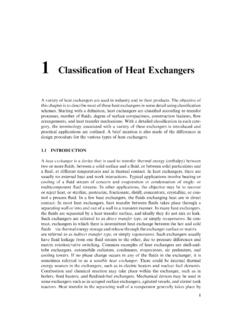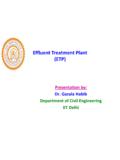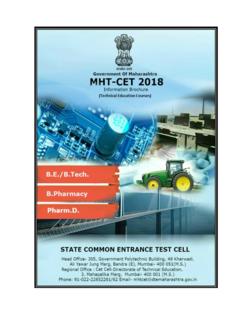Transcription of Adsorption from theory to practice - Indian Institute of ...
1 Advances in Colloid and Interface Science 93 2001. 135 224. Adsorption from theory to practice . browskiU. A. Da Faculty of Chemistry, odowska Uni ersity, 20031 Lublin, Poland Abstract Adsorption at various interfaces has concerned scientists since the beginning of this century. This phenomenon underlies a number of extremely important processes of utilitar- ian significance. The technological, environmental and biological importance of Adsorption can never be in doubt. Its practical applications in industry and environmental protection are of paramount importance. The Adsorption of substrates is the first stage in many catalytic processes.
2 The methods for separation of mixtures on a laboratory and on an industrial scale are increasingly based on utilising the change in concentration of compo- nents at the interface. Moreover, such vital problems as purification of water, sewages, air and soil are involved here too. On the other hand, many areas in which technological innovation has covered Adsorption phenomena have been expanded more through art and craft than through science. A basic understanding of the scientific principles is far behind; in part because the study of interfaces requires extremely careful experimentation if meaning- ful and reproducible results are to be obtained.
3 In recent years, however, considerable effort has been increasingly directed toward closing the gap between theory and practice . Crucial progress in theoretical description of the Adsorption has been achieved, mainly through the development of new theoretical approaches formulated on a molecular level, by means of computer simulation methods and owing to new techniques which examine surface layers or interfacial regions. Moreover, during the last 15 years new classes of solid adsorbents have been developed, such as activated carbon fibres and carbon molecular sieves, fullerenes and heterofullerenes, microporous glasses and nanoporous both carbonaceous and inorganic materials.
4 Nanostructured solids are very popular in science and technology and have gained extreme interest due to their sorption, catalytic, magnetic, optical and thermal properties. Although the development of Adsorption up to the 1918s has been following . Part of this article has been presented as the Keynote Lecture during AI-SCP'99 Conference, 24 27 May 1999, Beijing, China. U. Tel.: q48-81-537-5605; fax: q48-81-537-5685. E-mail address: A. Da 0001-8686r01r$ - see front matter 2001 Elsevier Science All rights reserved. PII: S 0 0 0 1 - 8 6 8 6 0 0 . 0 0 0 8 2 - 8. 136 browski r Ad ances in Colloid and Interface Science 93 (2001) 135 224. A. Da rather a zig zag path, this arm of surface science is now generally considered to have become a well-defined branch of physical science representing an intrinsically interdisci- plinary area between chemistry, physics, biology and engineering.
5 This review presents in brief the history of Adsorption and highlights the progress in theoretical description of the phenomenon under consideration. The paper deals with the above problems critically, showing the development of Adsorption , presenting some of the latest important results and giving a source of up-to-date literature on it. Moreover, in this paper the most important aspects are overviewed referring to today's trends and visions in application of Adsorption science in industry, environmental protection and in environmental analysis. The relationship between de elopment of Adsorption theory and Adsorption practice is pointed out.
6 Current understanding and perspectives pertaining to applications of Adsorption phenomena on laboratory and on industrial scale as well as environmental protection are discussed and illustrated by means of a few spectacular examples. 2001 Elsevier Science All rights reserved. Contents 1. Introduction .. 137. 2. Historical aspects .. 141. Pioneering experimental age .. 142. Pioneering theoretical age .. 143. 3. Catalysis and its relationship with Adsorption .. 153. 4. Current state of physical Adsorption .. 156. Adsorption on heterogeneous solids .. 156. Adsorption of single gases .. 156. Adsorption of gas mixtures .. 162. Adsorption of liquid mixtures.
7 163. Fractal approach to Adsorption .. 165. Kinetics and dynamics of Adsorption .. 166. Molecular modelling and its relevance to Adsorption phenomena .. 168. Future trends and prospects .. 172. 5. Basic types of industrial adsorbents .. 173. 6. Practical application of Adsorption .. 184. Industrial applications .. 185. Gas-phase application examples .. 192. Drying of gases and liquids by activated alumina .. 192. Production of nitrogen from air by means of carbon molecular sieves . 193. Liquid-phase application examples .. 194. Adsorption of proteins at solid liquid interface .. 194. Water treatment .. 196. Environmental applications .. 197.
8 Adsorption heat pumps .. 202. Adsorption devices in spacecraft environmental control .. 203. 7. Environmental analysis .. 204. Electrochemical analysis of adsorbable surface active substances SAS.. 204. Chromatographic methods proceeded by sampling and sample preparations .. 205. browski r Ad ances in Colloid and Interface Science 93 (2001) 135 224. A. Da 137. 8. Trends and perspectives .. 205. 9. Summary and conclusions .. 207. Acknowledgements .. 208. References .. 208. 1. Introduction Innumerable physical, chemical and biological processes take place at the boundary between two phases, while others are initiated at that interface. The change in concentration of a given substance at the interface as compared with the neighbouring phases is referred to as Adsorption .
9 Depending on the type of phases in contact, we can consider this process in the following systems: liquid gas, liquid liquid, solid liquid and solid gas. The major development of Adsorption processes on a large, industrial scale deals mainly with the solid gas w1 4x and solid liquid w5,6x interfaces, but in various laboratory separation techniques all types of interfaces are applied w7 11x. The term fluid' is commonly used to denote gas or liquid in contact with the boundary surface of solids. A basic concept in Adsorption occurring at every interface is the real Adsorption system. Let us consider this concept in terms of the solid gas interface.
10 The real Adsorption system can be defined as an equilibrium one including the adsorbent being in contact with the bulk phase and the so-called interfacial layer. This layer consists of two regions: the part of gas residing in the force field of the solid surface and the surface layer of the solid. The term Adsorption ' deals with the process in which molecules accumulate in the interfacial layer, but desorption denotes the converse process. Adsorption hysteresis is said to occur when the Adsorption and desorption curves deviate from one another. In such a case the isotherm possesses a hysteresis loop, the shape of which varies from one Adsorption system to another.


















